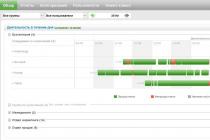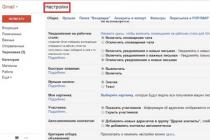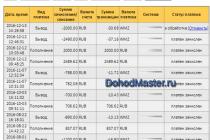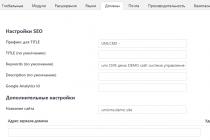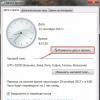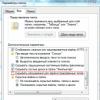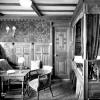In summer cottages, a television signal can rarely be received without amplification: it is too far from the repeater, the terrain, as a rule, is not uniform, and trees are in the way. For the normal quality of the "picture" antennas are needed. Anyone who knows at least a little how to handle a soldering iron can make an antenna for a summer residence with his own hands. Aesthetics outside the city are given not so great importance, the main thing is the quality of reception, simple design, cheapness and reliability. You can experiment and do it yourself.
Simple TV antenna
If the repeater is within 30 km from your dacha, you can make the receiving part, which is the simplest in design. These are two identical tubes connected by a cable. The cable output goes to the corresponding input on the TV.
The design of an antenna for a TV in the country: it's very easy to do it yourself (to increase the size of the picture, click on it with the left mouse button)
What is needed to make this TV antenna
First of all, you need to find out at what frequency the nearest TV tower is broadcasting. The length of the "whiskers" depends on the frequency. The broadcasting band is in the range of 50-230 MHz. It is divided into 12 channels. Each needs its own tube length. The list of terrestrial television channels, their frequencies and parameters of a television antenna for self-production will be given in the table.
| Channel number | Channel frequency | Length of the vibrator - from one end to the other end of the tubes, cm | Length of cables for the matching device, L1 / L2 cm |
|---|---|---|---|
| 1 | 50 MHz | 271-276 cm | 286 cm / 95 cm |
| 2 | 59.25 MHz | 229-234 cm | 242 cm / 80 cm |
| 3 | 77.25 MHz | 177-179 cm | 187 cm / 62 cm |
| 4 | 85.25 MHz | 162-163 cm | 170 cm / 57 cm |
| 5 | 93.25 MHz | 147-150 cm | 166 cm / 52 cm |
| 6 | 175.25 MHz | 85 cm | 84 cm / 28 cm |
| 7 | 183.25 MHz | 80 cm | 80 cm / 27 cm |
| 8 | 191.25 MHz | 77 cm | 77 cm / 26 cm |
| 9 | 199.25 MHz | 75 cm | 74 cm / 25 cm |
| 10 | 207.25 MHz | 71 cm | 71 cm / 24 cm |
| 11 | 215.25 MHz | 69 cm | 68 cm / 23 cm |
| 12 | 223.25 MHz | 66 cm | 66 cm / 22 cm |
So, in order to make an antenna for a TV with your own hands, you need the following materials:

It would be nice to have a soldering iron, flux for soldering copper and solder on hand: it is advisable to solder all the connections of the central conductors: the image quality will be better and the antenna will work longer. Then the places of rations must be protected from oxidation: it is best to fill it with a layer of silicone, you can use it with epoxy resin, etc. As a last resort, stick it with electrical tape, but this is very unreliable.
This homemade TV antenna, even at home, will be made by a child. It is necessary to cut the tube of the length that corresponds to the broadcasting frequency of the nearby repeater, then cut it exactly in half.
Assembly order
The resulting tubes are flattened on one side. With these ends, they are attached to the holder - a piece of getinax or textolite 4-6 mm thick (see figure). The tubes are placed at a distance of 6-7 cm from each other, their far ends should be at the distance indicated in the table. They are fixed to the holder with clamps, they must be held firmly.
The installed vibrator is fixed to the mast. Now you need to connect the two "mustaches" through the matching device. This is a cable loop with a resistance of 75 Ohm (type RK-1, 3, 4). Its parameters are indicated in the far right column of the table, and how it is done is on the right side of the photo.
The middle conductors of the cable are screwed (soldered) to the flattened ends of the tubes, their braid is connected with a piece of the same conductor. It is easy to get the wire: cut off a piece from the cable a little larger than the required size and free it from all the shells. Strip the ends and screw them to the cable conductors (it is better to solder).
Then the center conductors are connected from two pieces of the matching loop and the cable that goes to the TV. Their braid is also connected with a copper wire.
The last action: the loop in the middle is attached to the bar, and the cable going down is screwed to it. The bar is raised to the required height and there it is "tuned". To set up, two people are needed: one turns the antenna, the second watches TV and assesses the picture quality. Having determined where the signal is best received from, the hand-made antenna is fixed in this position. In order not to suffer with the "tuning" for a long time, look where the neighbors' receivers (terrestrial antennas) are directed. The simplest antenna for a summer residence is made by hand. Set and "catch" the direction by turning it along its axis.
Watch the video on how to cut a coaxial cable.
;
Looped from pipe
This antenna for giving with your own hands is a little more difficult to manufacture: you need a pipe bender, but the reception radius is greater - up to 40 km. Source materials almost the same: a metal tube, cable and rod.
The bend radius of the pipe is not important. It is necessary that the pipe has the required length, and the distance between the ends is 65-70 mm. Both "wings" should be the same length and the ends should be symmetrical about the center.

Homemade antenna for TV: a TV signal receiver with a receiving radius of up to 40 km is made from a piece of pipe and cable (to increase the size of the picture, click on it with the left mouse button)
The pipe and cable lengths are shown in the table. Find out on what frequency the nearest repeater is broadcasting, select the corresponding line. Saw off the pipe of the required size (the diameter is preferably 12-18 mm, the parameters of the matching loop are given for them).
| Channel number | Channel frequency | Length of the vibrator - from one end to the other, cm | Length of the cable for the matching device, cm |
|---|---|---|---|
| 1 | 50 MHz | 276 cm | 190 cm |
| 2 | 59.25 MHz | 234 cm | 160 cm |
| 3 | 77.25 MHz | 178 cm | 125 cm |
| 4 | 85.25 MHz | 163 cm | 113 cm |
| 5 | 93.25 MHz | 151 cm | 104 cm |
| 6 | 175.25 MHz | 81 cm | 56 cm |
| 7 | 183.25 MHz | 77 cm | 53 cm |
| 8 | 191.25 MHz | 74 cm | 51 cm |
| 9 | 199.25 MHz | 71 cm | 49 cm |
| 10 | 207.25 MHz | 69 cm | 47 cm |
| 11 | 215.25 MHz | 66 cm | 45 cm |
| 12 | 223.25 MHz | 66 cm | 44 cm |
Assembly
The tube of the required length is bent, making it absolutely symmetrical about the center. One edge is flattened and welded / sealed. Fill in the sands, and close up the second side. If there is no welding, you can plug the ends, just put the plugs on good glue or silicone.
The resulting vibrator is fixed on the mast (rod). They screw it to the ends of the pipe, and then solder the central conductors of the matching loop and the cable that goes to the TV. The next step is to connect a piece of uninsulated copper wire between the braided cables. The assembly is complete - you can proceed to the "setup".
Beer can antenna
Despite the fact that she looks frivolous, the image is much better. Checked repeatedly. Try it!
Outdoor beer can antenna

Putting it like this:
- In the bottom of the can, drill a hole (5-6 mm in diameter) strictly in the center.
- Pull the cable through this hole, take it out through the hole in the cover.
- We fix this jar to the left on the holder so that the cable is directed to the middle.
- We take out the cable from the can by about 5-6 cm, remove the insulation by about 3 cm, disassemble the braid.
- We cut the braid, its length should be about 1.5 cm.
- We distribute it over the surface of the can and solder it.
- The center conductor sticking out 3 cm must be soldered to the bottom of the second can.
- The distance between the two banks should be made as small as possible and fixed in some way. One option is sticky tape or duct tape.
- That's it, the homemade UHF antenna is ready.
End the other end of the cable with a suitable plug, plug it into the TV socket. This construction, by the way, can be used to receive digital television... If your TV supports this signal format (DVB T2) or you have a special attachment to your old TV, you can pick up the signal from the nearest repeater. You just need to find out where it is and direct your TV antenna, made with your own hands from tin cans, there.

Simple homemade antennas can be made from cans (beer or drinks). Despite the frivolity of the "components", it works very well, and it is made very simply
The same design can be adapted to receive VHF channels. Instead of 0.5 liter cans, put on 1 liter. Will accept the MV range.
Another option: if you don't have a soldering iron, or you don't know how to solder, you can make it easier. Tie two cans at a distance of several centimeters to the holder. Strip the end of the cable by 4-5 centimeters (carefully remove the insulation). Separate the braid, twist it into a bundle, make a ring out of it, into which you push a self-tapping screw. Make a second ring from the central conductor and thread a second self-tapping screw through it. Now, at the bottom of one cans, clean (with a sandpaper) a speck to which you screw the screws.
In general, soldering is needed for better contact: it is better to tin and solder the braid ring, as well as the place of contact with the metal of the can. But it turns out well on self-tapping screws, however, the contact is periodically oxidized and needs to be cleaned. How "snow" you will know - why ...
Antenna for digital TV do it yourself
Antenna design - loop. For this version of the receiver, you will need a wooden plank spider and a TV cable. You will also need electrical tape, a few nails. Everything.
We have already said that in order to receive a digital signal, you only need a decimeter terrestrial antenna and an appropriate decoder. It can be built into TVs (new generation) or made as a hotel device. If the TV has the function of receiving a signal in the DVB T2 code, connect the antenna output directly to the TV. If your TV does not have a decoder, you will need to purchase digital set-top box and connect the output from the antenna to it, and connect it to the TV set.
How to determine the channel and calculate the perimeter of the frames
In Russia, a program has been adopted according to which towers are constantly being built. By the end of 2015, the entire area should be covered with repeaters. Find the tower closest to you on the official website http: //xn--p1aadc.xn--p1ai/when/. The broadcast frequency and channel number are indicated there. The perimeter of the antenna frame depends on the channel number.

For example, on channel 37, broadcasting is carried out at a frequency of 602 MHz. The length of the wave is calculated as follows: 300/602 = 50 cm. This will be the perimeter of the frame. Let's calculate the other channel in the same way. Let it be 22 channel. Frequency 482 MHz, wavelength 300/482 = 62 cm.
Since this antenna consists of two frames, the length of the conductor should be equal to twice the wavelength, plus 5 cm for the connection:
- for channel 37, we take 105 cm of copper wire (50 cm * 2 + 5 cm = 105 cm);
- for channel 22, you need 129 cm (62 cm * 2 + 5 cm = 129 cm).
Assembly
Copper wire is best used from the cable that goes to the receiver. That is, take the cable and remove the sheath and braid from it, freeing the central conductor of the required length. Proceed with care it cannot be damaged.
- for channel 37: 50 cm / 4 = 12.5 cm;
- for channel 22: 62 cm / 4 = 15.5 cm.
The distance from one nail to another should correspond to these parameters. Laying copper wire begins on the right, from the middle, moving down and further along all points. Only in the place where the frames come close to one another, do not short-circuit the conductors. They should be at some distance (2-4 cm).

When the entire perimeter is laid, the braid from a cable several centimeters long is twisted into a bundle and soldered (wound, if it is impossible to solder) to the opposite edge of the frame. Next, the cable is laid as shown in the figure, wrapping it with electrical tape (it is possible more often, but the laying route cannot be changed). Then the cable goes to a decoder (separate or built-in). All the antenna for giving with your own hands for receiving digital television is ready.
How to make an antenna for digital television with your own hands - another design - is shown in the video.
When resting outside the city, sometimes, in addition to enjoying nature and fresh air, sometimes you want to watch your favorite TV series or an important football match. In contrast to the city, the coverage of villages with high-quality TV signals leaves much to be desired. In this situation, even the purchase of an antenna operating in a wide range of decimeter and meter waves does not guarantee a high-quality picture.
You can also try to assemble the antenna with your own hands, because a country house is the best place for experiments.

The simplest antenna option
As you can see in the photograph, the antenna is the simplest wave receiver. For manufacturing, you will need two tubes and a television cable, as well as knowledge of the signal transmission range of the nearest television tower.

Typically, reception is carried out at frequencies from 50 to 230 MHz, forming twelve channels. For each of them, tubes of certain sizes are used. To receive a signal at a frequency of 50 MHz, the distance between the outer edges of the tubes should be within 271-276 cm.On channel 12, the same distance is 66 cm.

Information about the dependence of the length of the blanks on the receiving frequency, as well as the schemes of homemade antennas, can be easily found on similar thematic Internet resources.

For making an antenna in artisanal conditions, we present you a list of what you can make an antenna from:
- Two tubes of steel, aluminum or any other metal alloy with a diameter of 8 to 24 mm. They must be the same in diameter, material and wall thickness.
- Availability of TV broadcast cable, rated for 75 Ohm resistance. The length of the wire is cut at the point of connection, taking into account the slack margin of 50 cm.
- Textolite blank or material from getinax (at least 5 mm thick).
- Fasteners for installing pipes on the holder.
- Bracket for the future antenna in the form of a metal pipe or corner. When installing the receiver at a low height, you can use a wooden stand.
- Soldering kit, anti-oxidation silicone fluid and electrical tape.






Assembly principle
The length-matched workpiece is divided into two equal tubes, which are crimped on one side. The tubes are fixed at a distance of 6-7 cm from each other, and their ends are fastened to the textolite blank with clamps. The resulting structure is fixed with a bar in an upright position.

To connect the cable, you must lay a loop designed for a resistance of 75 ohms. The middle conductors of the cable are stripped and twisted with flattened tube ends, and the braid is connected using a copper wire. The connection of the rest of the loop and the cable going to the output to the television device follows the same principle.






The resulting loop and the rest of the cable length, in order to avoid interference, should be securely fixed to the vertical stand. The required antenna height is adjusted locally, observing the signal change.

Beer can antenna
Is one of the most popular ideas for homemade TV signal receivers. Instead of pipes, in the absence of material, simple beer cans can be used.

For the manufacture of such a television receiver, the following parts are required:
- two beer cans of 0.5 l each;
- wooden or plastic piece 50 cm long;
- TV cable RG-58;
- soldering iron, flux for soldering on aluminum and solder;

To make a receiver from beer cans, follow the instructions below:
- Through the bottom of the can, in its center, a hole 5-6 mm in diameter is drilled.
- We lay the cable through the hole in the bank and bring it out through the neck.
- The can is fixed evenly on the left side of the workpiece in a horizontal position.
- We bring the cable through the neck to a distance of 5 cm, cut the insulation by 3 cm, remove the wire braid by 1.5 cm and solder it to the surface of the can.
- Solder the outgoing cable to the bottom of the second can.
- Attach the second can to the first at a minimum distance using tape or other sticky material.

The other end of the cable is fitted with a TV-in connector. This option antenna will fit and for digital broadcasting. If the TV supports the popular format (DVB T2), or there is a set-top box suitable for an old TV, then the signal can be received from the nearest relay tower. In this case, it is necessary to know the location of the repeater, in the direction of which the antenna should be directed to search for the signal.






This circuit is suitable for making an antenna designed to receive meter wave channels. Just use a liter container instead of half-liter cans.

In case you do not own soldering, there is another connection method. Two beer cans are attached at a minimum distance from the workpiece holding the entire structure. At the end of the cable, carefully remove the insulation 3-5 cm. Twist the braid of the wire into a bundle and, giving the shape of an eyelet, put it on the self-tapping screw.

In the same way, put the eyelet on the self-tapping screw at the second conductor. Then you connect the wires, using self-tapping screws, to each bank. In terms of long-term contact retention, soldering is much better than mechanical fasteners. It is advisable to tin the surface before soldering.

The fastening with self-tapping screws, although it is reliable, but when moisture gets on the antenna, the contacts of the home-made device oxidize, which will lead to a loss of signal.


Photo instructions on how to make an antenna



























When equipping a summer cottage, we try to make it as comfortable as possible for relaxation. This means that over time, it becomes overgrown with the conveniences to which we are so accustomed to in everyday life - water supply, heating and, of course, electricity. And where there is the latter, sooner or later television will certainly appear. But how, you ask, can you spend it at your dacha if the purchase of an antenna, which, by the way, is not cheap at all, is not provided for in your personal budget? It's very simple! A little bit of the basics of radio electronics, a couple of pieces of iron and a minimal soldering kit, and now, well tired in the garden, you sit on the dacha terrace to watch a block of evening news.
Radio electronics and television: simply about the complex
The most important thing for any antenna is its ability to interact with the signal spread over the air.
Currently, TV broadcasting is carried out in one single range - decimeter, and television transmitters cover almost the entire more or less populated area. This makes it possible to "catch" the TV signal anywhere.

But for this you have to take into account a few simple nuances.:

Proceeding from this, among the whole variety of television antennas, the most accessible for self-production will be such types as:
- All-wave (frequency independent)
It does not have high parameters, but it is the simplest and cheapest to manufacture - it is based on a metal frame, and ordinary beer cans or other tin containers act as receivers.

- Log-periodic range
Such an antenna can be compared to a fishing net, which, when caught, sorts the prey. This type The antenna systems also have a simple design, however, they provide higher parameters than the all-wavelength.

- Decimeter zigzag
For the decimeter range, the dimensions and complexity of the design of such an antenna are greatly simplified, and it can work in almost any receiving conditions.

The subtleties of making television antennas

The antenna elements, through which the useful signal currents pass, are always connected by soldering or welding. But if the device is placed outdoors, for example, on the roof of a country house, such contacts will corrode very soon.
If we are talking about a home-made antenna for a summer residence, you should not strive for the ideal quality of contacts - if they rust or burst, then in any case not soon. But it is desirable that the connections in the antenna design be as small as possible, which will ensure stable and fairly clean reception.
The braid and center conductor of coaxial cables is now made from inexpensive, corrosion resistant alloys. Unlike classic copper, they are poorly soldered. Therefore, care must be taken not to burn the cable.

For the manufacture of an antenna and its cable connection it is advisable to use:

You should not use aluminum wire for the manufacture of antenna elements - it will oxidize very quickly and lose the ability to conduct an electrical signal. Copper or cheaper brass is best suited for this.
The receiving area of the antenna should be as large as possible. To do this, several metal rods of the same metal should be symmetrically attached to the screen - a frame that filters out etheric and electrical noise.
Buying a basic signal amplifier that connects directly to the antenna will solve the problem with a weak and dirty signal.

As a result, the system will provide normal receive power. All that is needed for this is to put the antenna on the roof of the country house and point it towards the nearest television tower.
Frequency independent antenna do it yourself

The simplest all-wave is a pair of metal plates mounted on a wooden rail and connected by several turns of copper wire of any diameter. The width of such an antenna should be equal to its height, and the opening angle of the canvases should be 90 °. It is not necessary to solder the wire to the point of zero potential of the all-wave - it is enough to ensure its reliable fastening.
The frequency independent antenna is capable of receiving both meter and decimeter signals from almost any direction. The disadvantage of this option is the unity gain and zero CPV - an indicator of the ratio of the signal power received to the main lobe of the antenna to the sum of the interference power at the frequency received by the rest of the elements. That is why the all-wave is not suitable for receiving a TV signal in an area with strong interference or where the terrestrial signal is too weak.
For self-production of a frequency-independent antenna, you will need:
- antenna cable;
- several cans;
- self-tapping screws;
- plug;
- insulating tape;
- screwdriver;
- wooden lath;
- copper wire.
Banks are fixed on a rail (mast) with electrical tape at a distance of about 7 cm from each other.

Self-tapping screws are screwed into them, to the protruding ends of which the stripped ends are screwed antenna cable... The latter is fixed on the rail and laid along the external building structures of the country house to the place where you plan to put the TV.

You can improve the all-wave design by adding a few more sections from a tin container. After that, it remains to securely fix its mast in a vertical position, connect it to the TV and set up the tuner.
Another version of an all-wave antenna designed to receive a meter signal is a fan vibrator, which is popularly called a slingshot antenna.

Making a log-periodic TV antenna

Antenna "speech therapist" is a receiving line (a pair of metal tubes) with halves of linear dipoles perpendicularly connected to it - pieces of a conductor with a quarter-wave diameter of the working signal. The length and distance between the latter changes exponentially.
To manufacture a log-periodic antenna, a number of calculations must be performed:
- The calculation of the length of the dipoles starts from the second longest.
- Taking the reciprocal of the progression rate, the length of the longest dipole is calculated.
- Then it remains to calculate the shortest - the first - dipole, and then, based on the selected frequency range, the length of the "zero" dipole is taken.

To achieve the maximum receiving power, there should be a distance of 0.03-0.05 wavelengths between the dipoles, but not less than double the diameter of any of them.
The length of the finished LP antenna is about 400 mm. The diameter of the base of the LP antenna should be 8-15 mm, and the gap between their axes of the receiving line is taken no more than 3-4 diameters of the dipole.

For normal work LP antennas need to select a high-quality and fairly thick (about 6-8 mm in the sheath) coaxial cable. Otherwise, you will not be able to compensate for the attenuation of the decimeter waves, as a result of which the TV tuner will be unable to sense the signal.
The cable to the receiving line must not be fixed outside, as this sharply decreases the quality of signal reception.
When installing such an antenna, you need to ensure its wind resistance, and if you use a metal pipe as a mast, you need to install a dielectric insert - a wooden block - at least 1.5 cm long between it and the receiving line.
It is possible to improve the design of the LP antenna by installing linear or fan-shaped shoulders of a meter field on it. This system is called "delta".

Antenna diagram "Delta"
Zigzag antenna for summer cottages

The Z-antenna system with a reflector provides almost the same TV signal reception parameters as the LP antenna. However, its main petal is horizontally twice as long. This makes it possible to pick up a signal from different directions, which is especially true for rural areas.
The decimeter zigzag antenna has small dimensions, but its operating range is practically unlimited. The material for the manufacture of such a system is a copper tube or a sheet of aluminum with a thickness of about 6 mm. If you chose the latter, you will not be able to solder it with ordinary solder or flux - in this case, the fastenings are made with bolts. For outdoor installation, such an antenna will be ready only after the connection points are sealed with silicone.
The design of a zigzag antenna consists of the following elements:
- barbell;
- wire cloth;
- metal plates for fastening the canvas;
- transverse slats;
- dielectric plates and gaskets;
- mounting plate;
- feeder line;
- power plate.
Any of them can be made with your own hands from scrap materials or purchased at the nearest electronics store.
The sides of the Z-antenna are made all-metal or in the form of a mesh covered with a sheet of sheet metal. When routing coaxial cables over the body of the antenna, avoid sharp bends. To do this, it is enough to stretch it to the side capacitive insert and not let it go beyond its limits. At the point of zero potential, the braid of the cable is carefully soldered to the canvas.

This class also includes such types of antennas as ring and reflector, which are also not particularly difficult to manufacture.
Options for self-production of television antennas in the photo
There are other types of antennas suitable for self-production - wave, "Polish", simple loop and even primitive satellite. But whichever option you choose, a competent calculation of the parameters is required. The technique can be found in the technical literature on electronics. However, it is much easier and simpler to ask advice from those who already have experience in the manufacture of such antennas.
Self-made antenna for giving on video
Sometimes a television antenna breaks down at the most inopportune moment, or it is simply not at hand. For example, during a trip to the country. In this case, the question arises of how to make an antenna for a TV with your own hands from what is at hand.
With a homemade transmitter, you can watch a limited number of channels. And the reception may turn out to be of lower quality than that of a purchased device. And yet, knowing how to make an antenna yourself from improvised means can come in handy. An antenna can be simple or complex. The device will be able to receive almost all types of broadcasts.
Antenna types
Before you start making a TV antenna with your own hands, you should understand the types and technical characteristics television sets.
Depending on the installation site, a distinction is made between indoor and outdoor television sets. Indoor devices are only effective in areas with strong signal reception. They are not suitable for country TVs. For rural areas and areas remote from the TV repeater, outdoor TV sets are used.
By the type of signal amplifier, television receivers are active and passive. Passive type constructions receive and amplify impulses due to their own geometry. They do not need a power supply, do not introduce their own interference and noise into the signal they receive. It is easiest to make a passive antenna yourself.
Active devices are equipped with a signal amplifier that is powered from the mains. The active amplifier itself creates interference and distortion in the zone of reliable reception in case of choosing a too powerful or low-quality device.
Broadcasting is carried out on meter or decimeter waves. For reception of only meter or only decimeter bands of broadcasting, band TV receivers are best suited. For example, for the transmission of digital terrestrial television DVB-T2 in our country, only the decimeter range is used.
A log-periodic, or all-wave, television antenna can receive waves of both meter and decimeter ranges. This is a broadband design with 10 vibrators. A log-periodic device in terms of gain corresponds to a 3-4 element all-wave antenna.
Operating frequencies are limited by the largest and smallest vibrator in the receiver. It fits well with the feeder. Its gain does not change, then balancing and matching devices are not required to connect to the feeder.
A 75 ohm cable enters the lower tube, exits at the end (which is directed towards the telecenter) and is braided to the end of the lower tube and the core to the end of the upper tube.
Externally and according to the principle of operation, a log-periodic TV antenna consists of several channel-wave devices connected together. Moreover, each of them has its own vibrator, reflector and director. When a signal arrives, vibrators are excited that are closest in size to half of its wavelength. Such TV antennas are used to receive both digital and analogue broadcasts.

The wave channel receiver has the simplest design that can be quickly assembled from simple and affordable materials. It receives an analog TV signal near the TV tower and digital - outside large settlements, where there is little interference.
We use beer cans
Antenna for giving with your own hands from beer cans is the simplest and most affordable passive type design. It can be done quickly and in the absence of basic skills. At the same time, it does an excellent job of receiving decimeter broadcasting ranges.
To assemble an antenna from beer cans you will need:
- a cable of sufficient length;
- aluminum cans (for the simplest design, 2 is enough);
- 2 bolts or self-tapping screws;
- plug (F - connector) to connect the cable to the TV;
- electrical tape or tape;
- base made of wood or plastic for attaching cans (you can use wooden hangers for clothes).
The antenna circuit is simple:
- Each can is attached with electrical tape or tape to the base pin at a distance of 7 cm from each other.
- The cable is stripped from one side. They are bred and attached to the rings of the cans or to the screwed-in self-tapping screws. You can also solder it. A plug is attached to the free end.
This simple design is suitable for both indoor and outdoor installation. When used externally, the cans are covered with a large plastic container with the neck and bottom cut off. The cable is pulled through a hole made in the side, which can be sealed with boiling water. The finished receiver is connected and configured via automatic search channels.
You can also make an analogue of a satellite dish with your own hands. For this purpose, use a simple umbrella. You will also need:
- aluminium foil;
- copper cable;
- 1 tin can;
- amplifier and power supply to it.

DIY antenna for TV from beer cans
Operating procedure:
- The segments of the umbrella between the spokes are measured and the elements corresponding to these dimensions are cut out of the foil. Sew them to the umbrella dome, covering the entire inside of the umbrella.
- A television signal receiver is installed in the focus of the metal grating. The amplifier will be a core from which 4 cm of the braid was previously removed, and the cable shield, which protects against interference.
- An oval is cut out of an aluminum can. A hole is made in the center of it, through which a bare core is threaded and the contact is soldered. To protect against oxidation and corrosion, the joint is covered with plasticine.
- The amplifier is powered through the cable.
- Attach the receiver to the umbrella handle with tape so that it does not touch the metal. This will prevent interference and distortion. The junction must be covered with plasticine.
- The power supply is placed next to the TV, and the antenna is turned towards the repeater.
- The channels are set by driving the dish until the best signal is obtained.
This antenna works best if the tower is no further than 35 km from it.
We use wire
Another simple design is a homemade wire antenna. For its manufacture, you can use copper or brass wire. These materials are resistant to oxidation.
The wire must be stripped from the ends of the insulation. One of them is connected to the TV, and the other to the heating battery. The pipe is brought out to the roof - it will work as a signal amplifier. Such an antenna can receive no more than 5 signals. The wire can be pulled onto the balcony and secured to the clothesline.
You can make a TV antenna out of wire in another way. It will require:
- 2 pieces of copper wire 3-4 mm wide and 1.8 m long;
- a plate of plywood or metal measuring 15 by 15 cm;
- amplifier (old decimeter amplifiers can be used);
- electric drill;
- TV cable;
- iron pipe or fittings for making a mast;
- bolts.
Such a copper wire antenna is assembled as follows:
- Catchers are made, for which they bend the wire in the form of 2 rhombuses with sides of 45 cm. This is the optimal frame length for such a device.
- The resulting rhombuses are fixed on the base. To do this, at the attachment points, flattening the wire, drill holes and screw in the bolts.
- If a metal plate is used as a base, then a welding machine can be used to attach the trap.
- In the center, we fix the amplifier and connect the cable to it.
The easiest way is to use a metal pipe as a mast, which can be simply dug into the ground or attached to any suitable support. The antenna is fixed to the top of the mast and the cable is pulled through it. The entire structure is painted to protect against corrosion.
Another popular copper wire TV set that you can make yourself is a small antenna of an unusual shape "butterfly". For external use, such a device is made of wire 2-4 mm thick, for internal use - 2 mm and thinner.
To receive TV channels, make a frame. Frame length - 500 mm, width - 200 mm. It is twisted in such a way that 2 identical triangles are obtained, which are separated with pliers and soldered to the cable, leaving a 14 mm distance between the vertices. A plug is attached to the other end of the cable. The structure is attached with tape or electrical tape to a material with dielectric properties - wood, ebonite, plastic.

Home digital HDTV device
A powerful antenna for a TV, capable of receiving a signal at 490 MHz, is made from a transformer, which is better to purchase, since it will not be easy to make it yourself. You will also need:
- cardboard;
- Scotch:
- foil;
- stapler;
- glue.
For the manufacture of a television set, a scheme is used according to which all parts are cut out of cardboard. The elements are pasted over with foil, bent and cut. It is best to first find the template and diagram through a search engine and print it on a printer or redraw it from a printed publication.
First, you need to make a reflector about 35 cm long and glue it on one side with foil. 2 rectangles of the same size are cut in the middle for attaching the trap.
An antenna is assembled from the prepared parts. Departing 35 mm from the reflector, butterfly-shaped elements are glued to the plate. They can be attached with a stapler. In the middle of each such element, a hole is made for a cable to which a transformer is connected and a plug is attached.
Option for an apartment
You can make an antenna for indoor use in any of the above ways.
Another simple option at home is made as follows.
A simple loop indoor antenna with your own hands is made from copper wire or cable with foil in the winding. The device not only receives TV channels, but also acts as a selective filter against interference.
To calculate the size of the loop, you need to know the frequency of the wave for a given region. The loop length will be equal to the product of the coefficient (300 units) by the averaged frequency range.
Cut off the required amount of wire or cable, clean the edges if necessary. They fold a loop out of it and solder the telecable leading to the receiver. A plug is attached to it.
The structure can be suspended or installed on a stand. This simple device, with accurate calculations, is most effective for digital television.
A reliable device for the home is the diamond antenna. She is the simplest representative of zigzag television sets. To improve reception, it is equipped with capacitive inserts and a reflector.
The device is assembled from plates or tubes 1-1.5 cm wide made of brass, copper or aluminum. For the manufacture of capacitive inserts, foil, tin or metal mesh are used, which are soldered around the perimeter. The cable is laid from the center and on one side, avoiding sharp bends. He must not leave the frame.

In the days of huge tube TVs, a good antenna for high-quality analog TV reception was in short supply. Those that could be bought in stores were not of high quality. Therefore, people made UHF television antennas with their own hands. Today many are interested in homemade devices... And even when digital technologies are everywhere, this interest does not fade away.
Digital era
This era also touched on television. Today, T2 broadcasting is developing especially widely. It has its own characteristics. In those places where the signal level slightly exceeds the interference, a sufficiently high-quality reception is obtained. There is simply no further signal. The digital signal does not care about interference, however, in a situation of cable mismatch or various phase distortions, almost anywhere in the transmitting or receiving path, the picture can be squares even with a strong signal level.
Other changes have taken place in modern television. So, all broadcasting is carried out in the UHF range, the transmitters have good coverage. The conditions under which radio waves propagate through cities have changed dramatically.
Antenna parameters
Before you start manufacturing, you need to determine some of the parameters of these structures. They, of course, require in-depth knowledge in various areas of mathematics, as well as the laws of electrodynamics.
So, the gain is the ratio of the power at the input of the reference system to the power at the input of the antenna used. All this will work if each of the antennas creates the values of the intensity and flux density with the same parameters. The value of this coefficient is dimensionless.
Directional gain is the ratio of the field strength generated by the antenna to the field strength in any direction.

It must be remembered that parameters such as KU and KND are not interrelated. There is a UHF antenna for digital TV, which has a very high directivity. However, its gain is small. These constructions are directed into the distance. There are also highly directional designs. Here it comes in combination with a very powerful gain level.
Today you can not look for formulas, but use special programs... They have already taken into account all the necessary parameters. You just have to enter some conditions - and you will receive a complete calculation of the UHF antenna, in order to then assemble it.
Manufacturing nuances
Any structural element in which signal currents flow must be connected using a soldering iron or a welding machine. Such a knot, if it is in the open air, suffers from a breakdown in contact. From this, various antenna parameters and reception levels can become significantly worse.
This is especially true for points with zero potentials. According to experts, it is possible to observe the voltage in them, as well as the antinode of the current. More precisely, this is the maximum current value. Is it present at zero voltages? No wonder.
These areas are best made from solid metal. Creeping currents are unlikely to affect the picture if the connections are welded. However, due to their presence, the signal may be lost.
How and with what to solder?
A do-it-yourself UHF antenna is not very easy to make. This involves working with a soldering iron. Modern manufacturers tv cable no longer make it copper. Now there is an inexpensive alloy that is resistant to corrosion. These materials are difficult to solder. And if you heat them long enough, there is a risk of burning the cable.

Experts recommend using low-power soldering irons, low-melting solders, and fluxes. Do not spare the paste when soldering. The solder will lay down correctly only if it is under a layer of boiled flux.
Catch T2
In order to enjoy digital TV, it is enough to purchase a special tuner. But it doesn't have a built-in antenna. And those that are offered as special digital ones are too expensive and pointless.
Now we will learn how to catch T2 on a completely homemade construction. A homemade UHF antenna is simple, cheap, high quality. Try it yourself.
The simplest antenna
To assemble this structure, you will not even need to go to the store. To manufacture it, a conventional antenna cable is enough. You need 530 mm of wire for the ring and 175 mm from which the loop will be made.

The TV antenna itself is a ring of cable. The ends need to be stripped and then connected to the loop. And to the latter you need to solder a cable that connects to the T2 tuner. So, on the ring, the screen and the central core are connected to the loop screens. In the latter, the central veins are also connected. And the cable to the tuner is soldered as standard to the screen and the central core.
So the UHF antenna turned out, made by hand. Its design turned out to be very cheap and practical. And it works no worse than expensive store options. It needs to be fixed on plywood or plexiglass. Construction clamps are perfect for this.
"People's" antenna
This design is an aluminum disc. The outer diameter of the element should be 365 mm and the inner diameter 170 mm. The disc should be 1 mm thick. First you need to make a cut in the disc (10 mm wide). In the place where the cut is made, a PCB made of PCB should be installed. It should be 1 mm thick.

The board must have holes for the MZ screws. The board must be glued to the disk. Then you need to solder the cable leads to it. The center core should be soldered to one side of the disc, the shield to the other. In terms of quality, such a TV antenna will receive better with two discs, especially if it is located far from the TV repeater.
Universal antenna
Nothing supernatural will be used to make this structure. We will make it from various materials at hand. However, although it is homemade, it will work perfectly in the entire decimeter range. So, this UHF antenna, quickly made with its own hands, is in no way inferior to store-bought, more expensive designs. To receive T2, it will be enough completely.

So, to assemble this structure, you need empty cans of canned food or beer. You need 2 cans with a diameter of 7.5 cm. The length of each is 9.5 cm. You also need to stock up on strips of textolite or getinax, always with foil.
Our cans need to be connected to the PCB strips using a soldering iron. The plate of this material, which will connect the containers at the top, must be covered with a continuous copper foil. On the bottom plate, the foil should be cut. This is done for convenient cable connection.
It is necessary to assemble the structure in such a way that the total length is not less than 25 cm. This antenna (UHF range) is a broadband balanced dipole. Due to its surface area, it has high amplification factors.
If suddenly you cannot find suitable cans, then you can use containers with a smaller diameter. However, then the foil will have to be cut at the top connecting plate as well.
"Beer" antenna
Do you like to drink beer? Don't throw away the cans. You can make of them good antenna... To do this, you need to fix two beer cans on any dielectric material.
First you need to choose the right cable, and then bring it to mind. For this, the cable must be stripped. You will see a shielding foil. There will be a protective layer underneath. But under it you can directly observe the cable.
For our antenna, we need to strip the top layer of this wire about 10 cm. The foil needs to be carefully twisted so that we end up with a branch. The protective layer for the central core must be stripped by 1 cm.
On the other hand, you need to solder the TV plug to the cable. If you were a subscriber of cable networks, then this part and cable will not even have to be purchased separately.
Now for the cans. It is advisable to use beer containers with a volume of 1 liter. However, good German beer in such cans is expensive, and domestic beer is not sold.

Banks need to be uncorked very carefully. Then you need to free the container from the contents, and then dry it well. Next, using a self-tapping screw, connect our screen on the cable and the jar. The central core must be screwed to the second.
For more High Quality images it is better to connect the containers and the cable with a spike.
It is necessary to fix the cans on some kind of dielectric material. It should be noted that they should be located on one straight line. The distance between them depends on the capacity. All this is selected only empirically.
Zigzag
The UHF zigzag antenna has the most simple design. The part itself is broadband. Its device allows for various deviations from the initial design parameters. In this case, its electrical parameters are almost not violated.
Its input impedance in a certain range depends on the size of the conductors that will form the basis of the canvas. There is a dependence here. The greater the width or thickness of the conductors, the better the antenna will be matched to the feeder. In general, any conductors can be used to make the web. Plates, tubes, corners, and much more are suitable for this.

In order to increase the directivity of such an antenna, it is permissible to use a flat screen, which will act as a reflector. The latter will reflect high-frequency energy towards the antenna. Such screens are often of serious size, and the phase depends mainly on the distance.
From a practical point of view, a reflector is rarely made of a solid sheet of metal. More often it is made in the form of conductors that are connected in one plane. For design reasons, you should not make a screen that is too dense. The conductors from which the screen itself will be made are connected by welding or soldering to a metal frame.

This design is made very simply. It works well in the UHF range. In the USSR, it was a real people's irreplaceable model. It has a small size, so it can be used as an indoor UHF antenna.
The material will be copper tubes or an aluminum sheet. The side pieces can be solid metal. Often they are covered with a net or covered with a tin. If one of the indicated methods is used, in this case, the structure must be soldered along the contour.
Do not bend the cable sharply. How to carry out this element, you can see in the pictures presented.
It must be guided in such a way that it reaches the side corner, but does not go beyond the antenna or side square.
Indoor antenna MV DMV
This design is designed for easy and reliable reception of digital TV signals. It can be made easily and very quickly. To do this, you need an aluminum or copper bar. Its length should be up to 1800 mm. This antenna can also be used as an outdoor antenna.

The design is a rhombus-shaped frame. There should be two of them. One acts as a vibrator, the other acts as a reflector. To receive T2, it is necessary that the side of our rhombus is approximately 140 mm, and the distance between them is 100 mm.

After the frame is made and the structure gains rigidity, a dielectric is mounted between the two ends of our rod. It could be anything. The shape and size are completely unimportant. The distance between two points of the bars should be approximately 20 mm. The tops of our rhombuses need to be connected.

The feeder can be made from a cable. It must be connected to brass or copper petals, which should already be attached to the antenna lead.
If the resulting design does not meet your expectations, for example, poor reception quality or the repeater is far away, you can equip the antenna with an amplifier, and you will end up with an active UHF antenna. It is used both in the city and in the country.
The simplest UHF loop antenna
This construction resembles the number "zero". By the way, this is the coefficient of its amplification. It is ideal for T2 reception. This part is capable of performing better than the products offered in stores.
It is also called digital, because with it you can perfectly catch digital broadcasting. It is narrowband, which is a significant advantage. It works on the principle of a selective valve, which makes it possible to talk about reliable protection against interference.

For assembly, you will need an ordinary 75 ohm coaxial cable, as well as a regular TV plug. It is better to choose a cable with a large diameter from all options. You can use a cardboard box or something else as a stand.
How long the frame will be, we determine using programs for calculating antenna parameters. The material for making the frame can be used the same as for the cable. By the way, for calculations, you need to know the frequencies of digital broadcasting in your city.

The central core of the cable is not needed in the frame structure. The stripped wire is twisted together with the core and braid of the frame. Then this connection must be soldered.
The structure must be placed on a dielectric base. Better to keep it away from your tuner. It is important that there is no voltage at the antenna input.
So, we figured out how the UHF antenna is made with our own hands. As you can see, this is not a very difficult task. But now you can watch your favorite TV shows in digital quality. And such a structure is installed in the same way as an ordinary store one - on the roof. Screws or bolted connections can be used. It should be installed in a safe place so that during gusts of wind it does not fly off along with a piece of slate. It is desirable that the antenna be mounted at the highest possible height. In this way, you will eliminate the appearance of interference during the broadcasting of cable or digital television.





